Rural Landscape Changes in the Piedmont Region (Italy). A Method for the Interpretation of Possible Effects of CAP
Abstract
:1. Introduction
2. Materials and Methods
2.1. Selection of the Areas
2.2. Analysis of Land Use Change at Supra-Local Scale
2.3. Landscape Change Analysis at Local Scale
3. Results
3.1. The Selected Areas in Piedmont (Italy)
3.2. Results of the Piedmont Case Study
4. Discussion
- Possible positive effects and trade-off: according to the assessment results at the supra-local scale, the CAP has contributed positively to the maintenance of agricultural activity and the protection of rural areas, although it is not sufficiently equipped to oppose land consumption and urban sprawl. The presence of farmers also shows positive results of the management of invasive wood species. At the same time, the evaluation at the local scale shows that intensive agriculture can profoundly alter the structure of the landscape and erase the traditional landscape signs (shape, variety, number of components, etc.). The study has also highlighted that the maintenance of traditional crops and practices, such as rice crops in Novara, facilitates the conservation and enhancement of the structure of the landscape mosaic. On the one hand, the CAP seems to favor the protection of the soil. On the other hand, it strengthens some intensive forms of agriculture aimed at maximizing productivity that contribute to the reduction in components and variety of the rural landscape.
- Strengths and weaknesses of the method: the absence of some spatial data and the lack of updating could be relevant issues for the application of this method, particularly regarding land use and cover. In addition, it is not always possible to match these data with the beginning and the end of the programming cycles in order to conduct a pre-post evaluation. Sometimes, the results are obtained on years that are before the implementation of the 2007–2013 CAP (i.e., under the 2000–2006 CAP) and after this period (under the 2014–2020 CAP), mainly due to data availability. At the same time, the identification of areas to be examined should take into account their intrinsic conditions and landscape character, as well as consider similar areas from an agronomic and environmental point of view. Among the limiting aspects, it is also necessary to consider that the proposed method requires high technical skills and significant processing times, especially at the locale scale. For these reasons, it was not possible to test the method at the local scale in other areas. However, future directions of research might apply the landscape change method and evaluate landscapes metrics on some less-CAP-covered areas in order to have a case control and verify some hypothesis as well as cause and effect relationships.
- Application field: the method proposed was developed in order to support the CAP evaluation at regional and locale scales, in the different phases. It could be applied to the next ex-post evaluation and even to all phases of the CAP 2023–2027 evaluation. It can be used in the ex-post evaluation to answer the common evaluation questions in the RDP (Q8 and Q26) and describe how the RDP and the CAP in general have contributed to landscape protection and enhancement. In the CAP 2023–2027 evaluation, the method could be useful to assess the contribution of the CAP to “protection of biodiversity, enhance ecosystem services and preserve habitats and landscapes” (objective 6). It could be used as a proxy for the next CAP strategic plans, to set up target indicators and for the evaluation of impact and context indicators such as “Enhanced provision of ecosystem services: share of UAA covered with landscape features (I20)” [40].
5. Conclusions
Funding
Data Availability Statement
Acknowledgments
Conflicts of Interest
References
- Wiggins, S.; Proctor, S. How Special Are Rural Areas? The Economic Implications of Location for Rural Development. Dev. Policy Rev. 2001, 19, 427–436. [Google Scholar] [CrossRef]
- Roman, M.; Roman, M.; Prus, P.; Szczepanek, M. Tourism Competitiveness of Rural Areas: Evidence from a Region in Poland. Agriculture 2020, 10, 569. [Google Scholar] [CrossRef]
- Simoncini, R.; Ring, I.; Sandström, C.; Albert, C.; Kasymov, U.; Arlettaz, R. Constraints and Opportunities for Mainstreaming Biodiversity and Ecosystem Services in the EU’s Common Agricultural Policy: Insights from the IPBES Assessment for Europe and Central Asia. Land Use Policy 2019, 88, 104099. [Google Scholar] [CrossRef]
- Alliance Environnement. Evaluation of the Impact of the CAP on Habitats, Landscapes, Biodiversity: Final Report; Publications Office of the European Union: Luxembourg, 2020. [Google Scholar]
- Concepción, E.D.; Díaz, M.; Baquero, R.A. Effects of Landscape Complexity on the Ecological Effectiveness of Agri-Environment Schemes. Landsc. Ecol 2008, 23, 135–148. [Google Scholar] [CrossRef]
- Delattre, L.; Debolini, M.; Paoli, J.C.; Napoleone, C.; Moulery, M.; Leonelli, L.; Santucci, P. Understanding the Relationships between Extensive Livestock Systems, Land-Cover Changes, and Cap Support in Less-Favored Mediterranean Areas. Land 2020, 9, 518. [Google Scholar] [CrossRef]
- Pardo, A.; Rolo, V.; Concepción, E.D.; Díaz, M.; Kazakova, Y.; Stefanova, V.; Marsden, K.; Brandt, K.; Jay, M.; Piskol, P.; et al. To What Extent Does the European Common Agricultural Policy Affect Key Landscape Determinants of Biodiversity? Environ. Sci. Policy 2020, 114, 595–605. [Google Scholar] [CrossRef]
- Penko Seidl, N.; Golobič, M. The Effects of EU Policies on Preserving Cultural Landscape in the Alps. Landsc. Res. 2018, 43, 1085–1096. [Google Scholar] [CrossRef]
- Hart, K.; Bas-Defossez, F. CAP 2021–27: Proposals for Increasing Its Environmental and Climate Ambition, Report for NABU by IEEP; Institute for European Environmental Policy: Brussels, Belgium, 2018. [Google Scholar]
- European Commission (EC). Proposal for a Regulation of the European Parliament and of the Council Establishing Rules on Support for Strategic Plans to Be Drawn Up by Member States under the Common Agricultural Policy (CAP Strategic Plans) and Financed by the European Agricultural Guarantee Fund (EAGF) and by the European Agricultural Fund for Rural Development (EAFRD) and Repealing Regulation (EU) n. 1305/2013 of the European Parliament and of the Council and Regulation (EU) n. 1307/2013 of the European Parliament and of the Council; COM/2018/392 Final—2018/0216 (COD); European Commission (EC): Brussels, Belgium, 2018; Available online: https://eur-lex.europa.eu/resource.html?uri=cellar:aa85fa9a-65a0-11e8-ab9c-01aa75ed71a1.0003.02/DOC_1&format=PDF (accessed on 21 November 2021).
- Tyllianakis, E.; Martin-Ortega, J. Agri-Environmental Schemes for Biodiversity and Environmental Protection: How We Are Not Yet “Hitting the Right Keys”. Land Use Policy 2021, 109, 105620. [Google Scholar] [CrossRef]
- Directorate-General for Agriculture and Rural Development (European Commission); ECORYS; Institute for European Environmental Policy; Wageningen University and Research. Mapping and Analysis of the Implementation of the CAP: Final Report; Publications Office of the European Union: Luxembourg, 2016. [Google Scholar]
- European Court of Auditors (ECA). Is Agri-Environment Support Well Designed and Managed? Special Report n. 7/2011; Publications Office of The European Union: Luxembourg, 2011. [Google Scholar]
- Piorr, A.; Ungaro, F.; Ciancaglini, A.; Happe, K.; Sahrbacher, A.; Sattler, C.; Uthes, S.; Zander, P. Integrated Assessment of Future CAP Policies: Land Use Changes, Spatial Patterns and Targeting. Environ. Sci. Policy 2009, 12, 1112–1136. [Google Scholar] [CrossRef]
- European Commission (EC); Directorate-General for Agriculture and Rural Development—Unit C.4. Guidelines: Assessing RDP Achievements and Impacts in 2019; European Commission: Brussels, Belgium, 2018. [Google Scholar]
- Schmidt, M.; Weißhuhn, P.; Augustin, J.; Funk, R.; Häfner, K.; König, H.; Loft, L.; Merz, C.; Meyer, C.; Piorr, A.; et al. Evaluation of the Ecosystem Ser-Vices Approach in Agricultural Literature. One Ecosyst. 2017, 2, E11613. [Google Scholar] [CrossRef] [Green Version]
- Swinton, S.M.; Lupi, F.; Robertson, G.P.; Hamilton, S.K. Ecosystem Services and Agriculture: Cultivating Agricultural Ecosystems for Diverse Benefits. Ecol. Econ. 2007, 64, 245–252. [Google Scholar] [CrossRef]
- Van Zanten, B.T.; Verburg, P.; Espinosa, M.; Gomez-Y-Paloma, S.; Galimberti, G.; Kantelhardt, J.; Kapfer, M.; Lefebvre, M.; Manrique, R.; Piorr, A.; et al. European Agricultural Landscapes, Common Agricultural Policy and Ecosystem Services: A Review. Agron. Sustain. Dev. 2014, 34, 309–325. [Google Scholar] [CrossRef] [Green Version]
- Ungaro, F.; Zasada, I.; Piorr, A. Mapping Landscape Services, Spatial Synergies and Trade-Offs. A Case Study Using Variogram Models and Geostatistical Simulations in an Agrarian Landscape in North-East Germany. Ecol. Indic. 2014, 46, 367–378. [Google Scholar] [CrossRef]
- Ungaro, F.; Häfner, K.; Zasada, I.; Piorr, A. Mapping Cultural Ecosystem Services: Connecting Visual Landscape Quality to Cost Estimations for Enhanced Services Provision. Land Use Policy 2016, 54, 399–412. [Google Scholar] [CrossRef]
- Medeiros, A.; Fernandes, C.; Gonçalves, J.F.; Farinha-Marques, P. Research Trends on Integrative Landscape Assessment Using Indicators—A Systematic Review. Ecol. Indic. 2021, 129, 107815. [Google Scholar] [CrossRef]
- Rega, C.; Short, C.; Pérez-Soba, M.; Paracchini, M.L. A Classification of European Agricultural Land Using an Energy-Based Intensity Indicator and Detailed Crop Description. Landsc. Urban Plan. 2020, 198, 103793. [Google Scholar] [CrossRef]
- Plaza Tabasco, J.; Martínez Sánchez-Mateos, H.S. Integration Versus Fragmentation, the Role of Minor Rural Networks in Rural Cultural Landscapes. A Study-Case in Spain. Sustainability 2021, 13, 4765. [Google Scholar] [CrossRef]
- Rega, C.; Bartual, A.; Bocci, G.; Sutter, L.; Albrecht, M.; Moonen, A.; Jeanneret, P.; Van Der Werf, W.; Pfister, S.C.; Holland, J.M.; et al. A Pan-European Model of Landscape Potential to Support Natural Pest Control Services. Ecol. Indic. 2018, 90, 653–664. [Google Scholar] [CrossRef]
- Rega, C.; Helming, J.; Paracchini, M.L. Environmentalism and Localism in Agricultural and Land-Use Policies Can Maintain Food Production While Supporting Biodiversity. Findings from Simulations of Contrasting Scenarios in the EU. Land Use Policy 2019, 87, 103986. [Google Scholar] [CrossRef]
- Kay, S.; Rega, C.; Moreno, G.; Herder, M.; Palma, J.H.N.; Borek, R.; Crous-Duran, J.; Freese, D.; Giannitsopoulos, N.; Graves, A.; et al. Agroforestry Creates Carbon Sinks Whilst Enhancing the Environment in Agricultural Landscapes in Europe. Land Use Policy 2019, 83, 581–593. [Google Scholar] [CrossRef]
- Mouchet, M.A.; Rega, C.; Lasseur, R.; Georges, D.; Paracchini, M.L.; Renaud, J.; Stürck, J.; Schulp, C.J.E.; Verburg, P.H.; Verkerk, P.J.; et al. Ecosystem Service Supply by European Landscapes under Alternative Land-Use and Environmental Policies. Int. J. Biodivers. Sci. Ecosyst. Serv. Manag. 2017, 13, 342–354. [Google Scholar] [CrossRef]
- Haines-Young, R.H. Tracking Change in the Character of English Landscape, 1999–2003; Catalogue Number NE42; Natural England: York, UK, 2007.
- Tudor, C. An Approach to Landscape Character Assessment; Natural England: York, UK, 2014.
- Cassatella, C. L’interpretazione Strutturale Del Paesaggio E Il Piano Come Risorsa Conoscitiva [The Interpretation of Landscape Structure And The Plan as a Knowledge Resource]. Atti E Rass. Tec. Della Soc. Degli Ing. E Degli Archit. Torino 2018, 3, 63–67. [Google Scholar]
- Van Eetvelde, V.; Antrop, M. Indicators for Assessing Changing Landscape Character of Cultural Landscapes in Flanders (Belgium). Land Use Policy 2009, 26, 901–910. [Google Scholar] [CrossRef]
- Gottero, E.; Cassatella, C. Landscape Indicators for Rural Development Policies. Application of a Core Set in the Case Study of Piedmont Region. Environ. Impact Assess. Rev. 2017, 65, 75–85. [Google Scholar] [CrossRef]
- Uuemaa, E.; Antrop, M.; Roosaare, J.; Marja, R.; Mander, Ü. Landscape Metrics and Indices: An Overview of Their Use in Landscape Research. Living Rev. Landsc. Res. 2009, 3, 1–28. [Google Scholar] [CrossRef]
- Cassatella, C.; Peano, A. Landscape Indicators: Assessing and Monitoring Landscape Quality; Springer: Berlin/Heidelberg, Germany, 2011. [Google Scholar]
- Plieninger, T.; Draux, H.; Fagerholm, N.; Bieling, C.; Bürgi, M.; Kizos, T.; Kuemmerle, T.; Primdahl, J.; Verburg, P.H. The Driving Forces of Landscape Change in Europe: A Systematic Review of the Evidence. Land Use Policy 2016, 57, 204–214. [Google Scholar] [CrossRef] [Green Version]
- Copus, A. Shrinking Rural Areas: A Fresh Look at an Old Problem. Territ. ESPON Mag. 2020, 1, 42–43. [Google Scholar]
- ESPON. Shrinking Rural Regions in Europe: Towards Smart and Innovative Approaches to Regional Development Challenges in Depopulating Rural Regions; Policy Brief; ESPON: Luxembourg, 2017. [Google Scholar]
- Estel, S.; Kuemmerle, T.; Alcántara, C.; Levers, C.; Prishchepov, A.V.; Hostert, P. Mapping Farmland Abandonment and Recultivation Across Europe Using MODIS NDVI Time Series. Remote Sens. Environ. 2015, 163, 312–325. [Google Scholar] [CrossRef]
- Primdahl, J.; Swaffield, S. (Eds.) Globalisation and Agricultural Landscapes: Change Patterns and Policy Trends in Developed Countries; Cambridge University Press: Cambridge, UK, 2010. [Google Scholar]
- European Commission (EC). Proposal for a Regulation of the European Parliament and of the Council Establishing Rules on Support for Strategic Plans to Be Drawn Up by Member States under the Common Agricultural Policy (CAP Strategic Plans) and Financed by the European Agricultural Guarantee Fund (EAGF) and by the European Agricultural Fund For Rural Development (EAFRD) and Repealing Regulation (EU) n.1305/2013 Of the European Parliament and of the Council and Regulation (EU) No 1307/2013 of the European Parliament and of the Council; COM/2018/392 Final—2018/0216 (COD)—Annex I—Impact, Result and Output Indicators Pursuant to Article 7; European Commission (EC): Brussels, Belgium, 2018; Available online: https://eur-lex.europa.eu/resource.html?uri=cellar:aa85fa9a-65a0-11e8-ab9c-01aa75ed71a1.0003.02/DOC_2&format=PDF (accessed on 21 November 2021).
- European Commission (EC). A Long-Term Vision for the EU’s Rural Areas—Towards Stronger, Connected, Resilient and Prosperous Rural Areas by 2040; COM(2021) 345 Final; European Commission (EC): Brussels, Belgium, 2021. [Google Scholar]
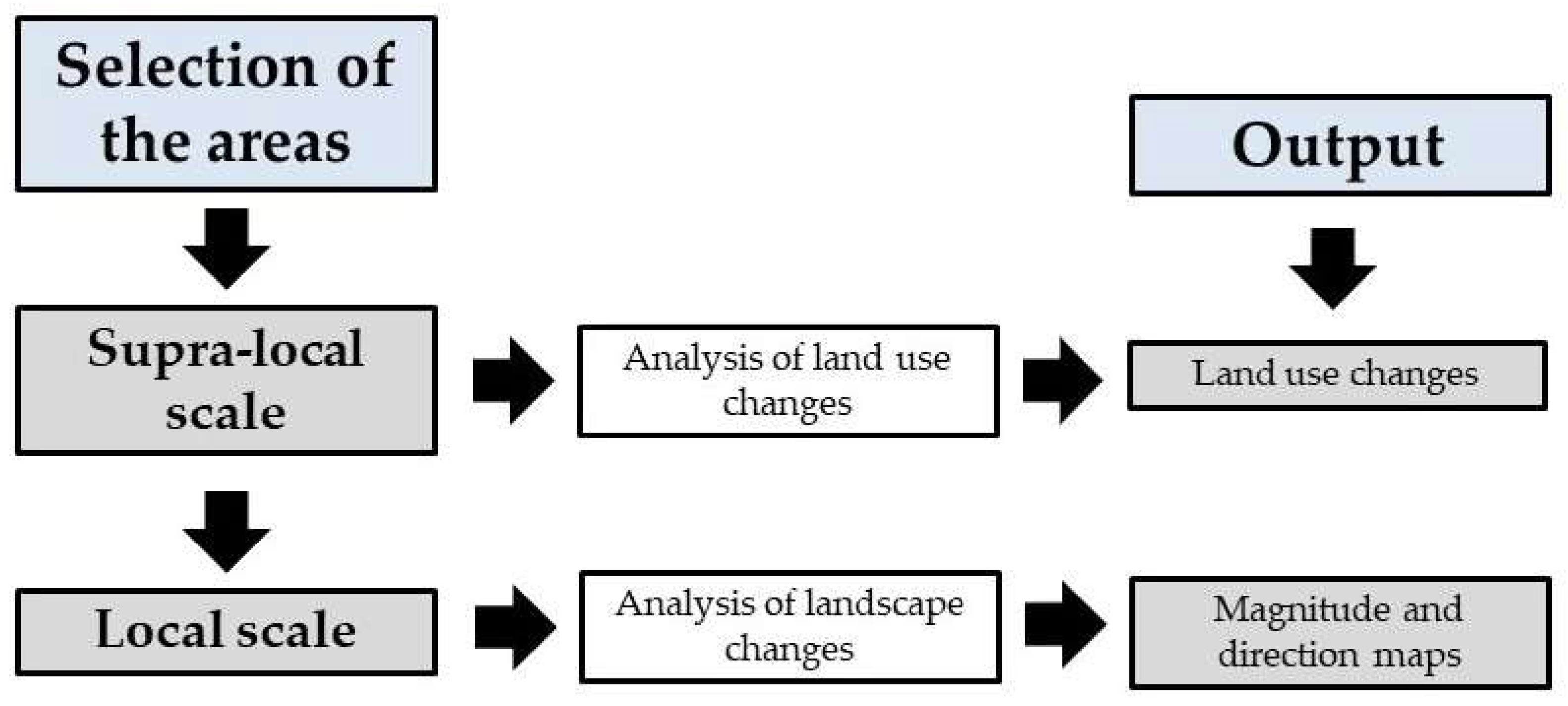
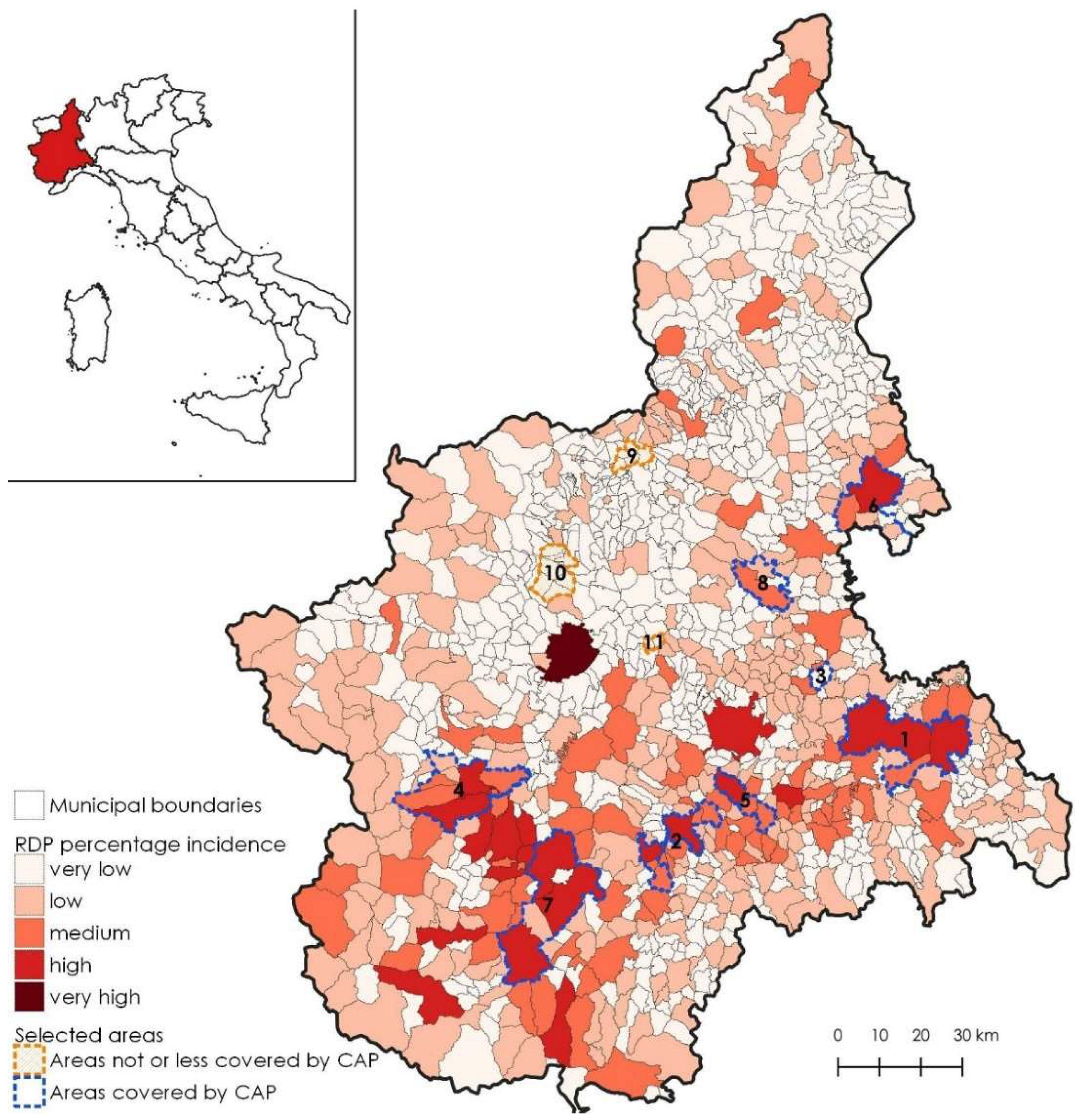
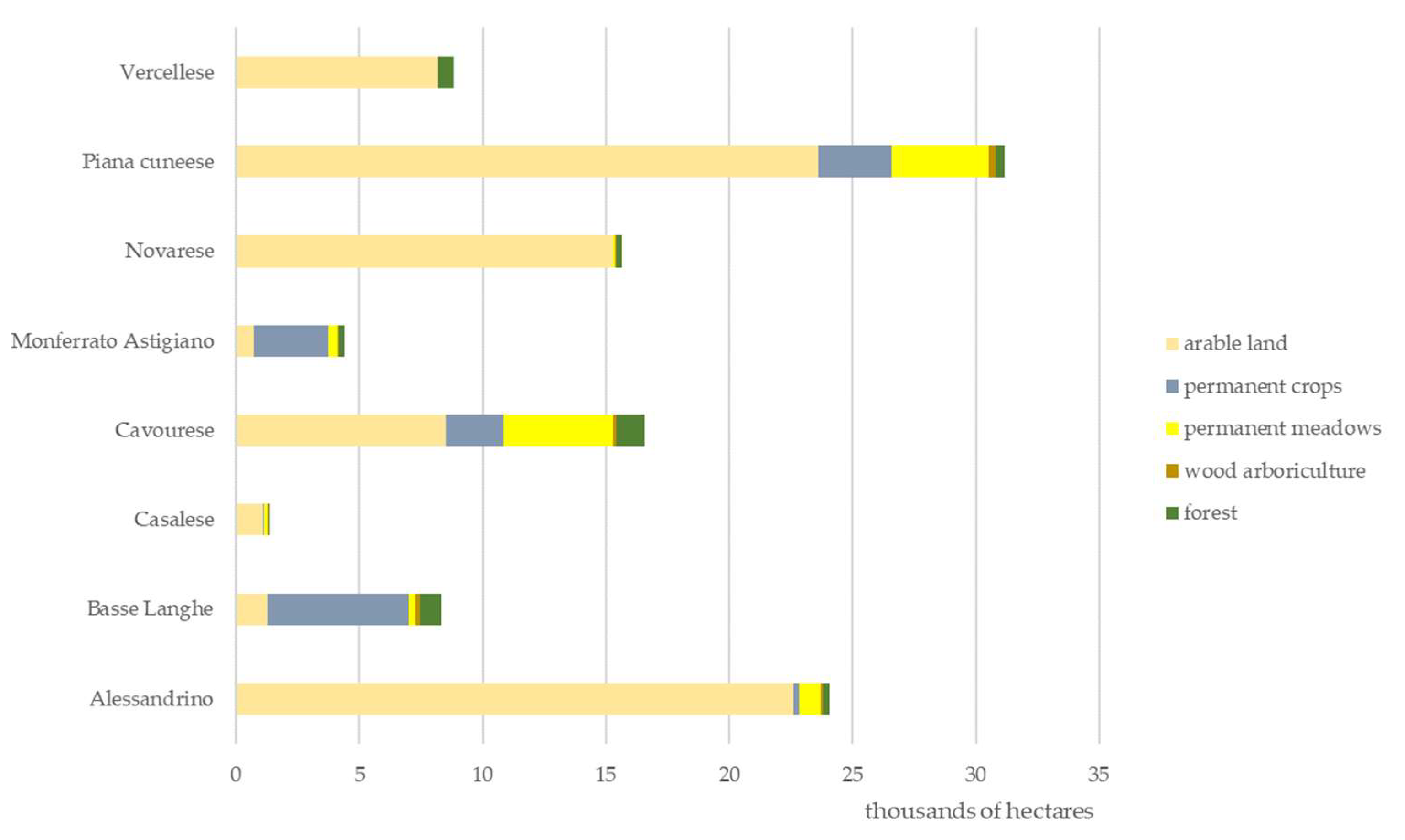
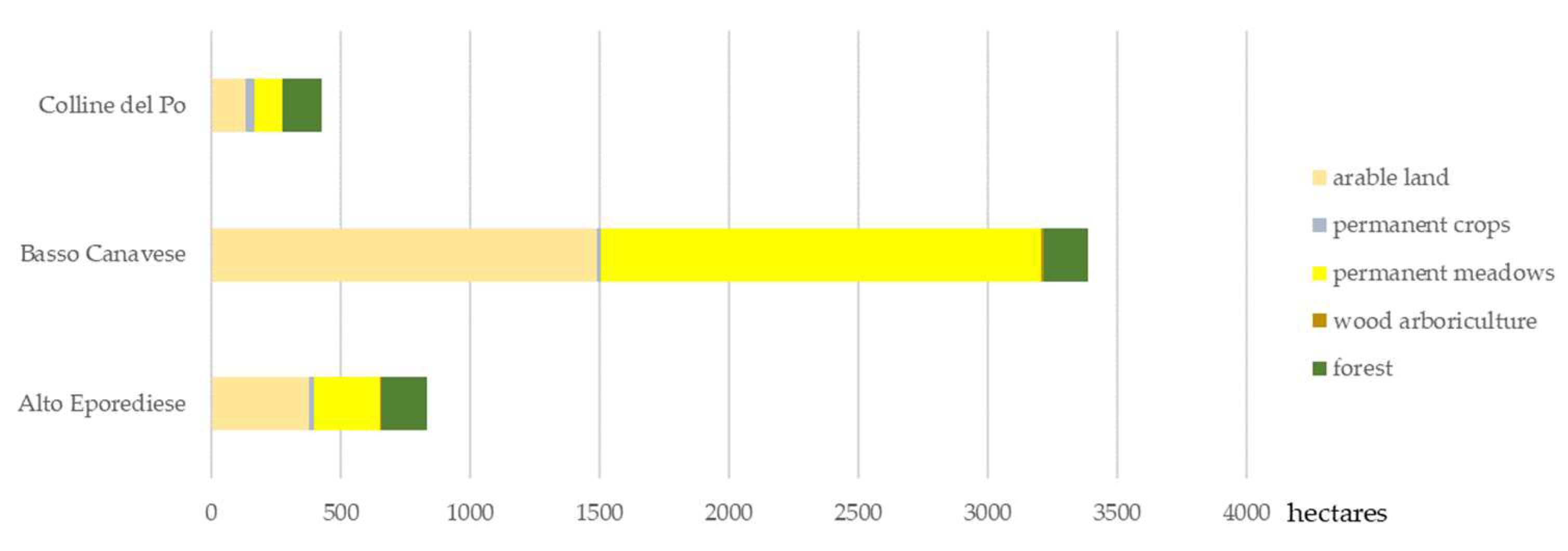
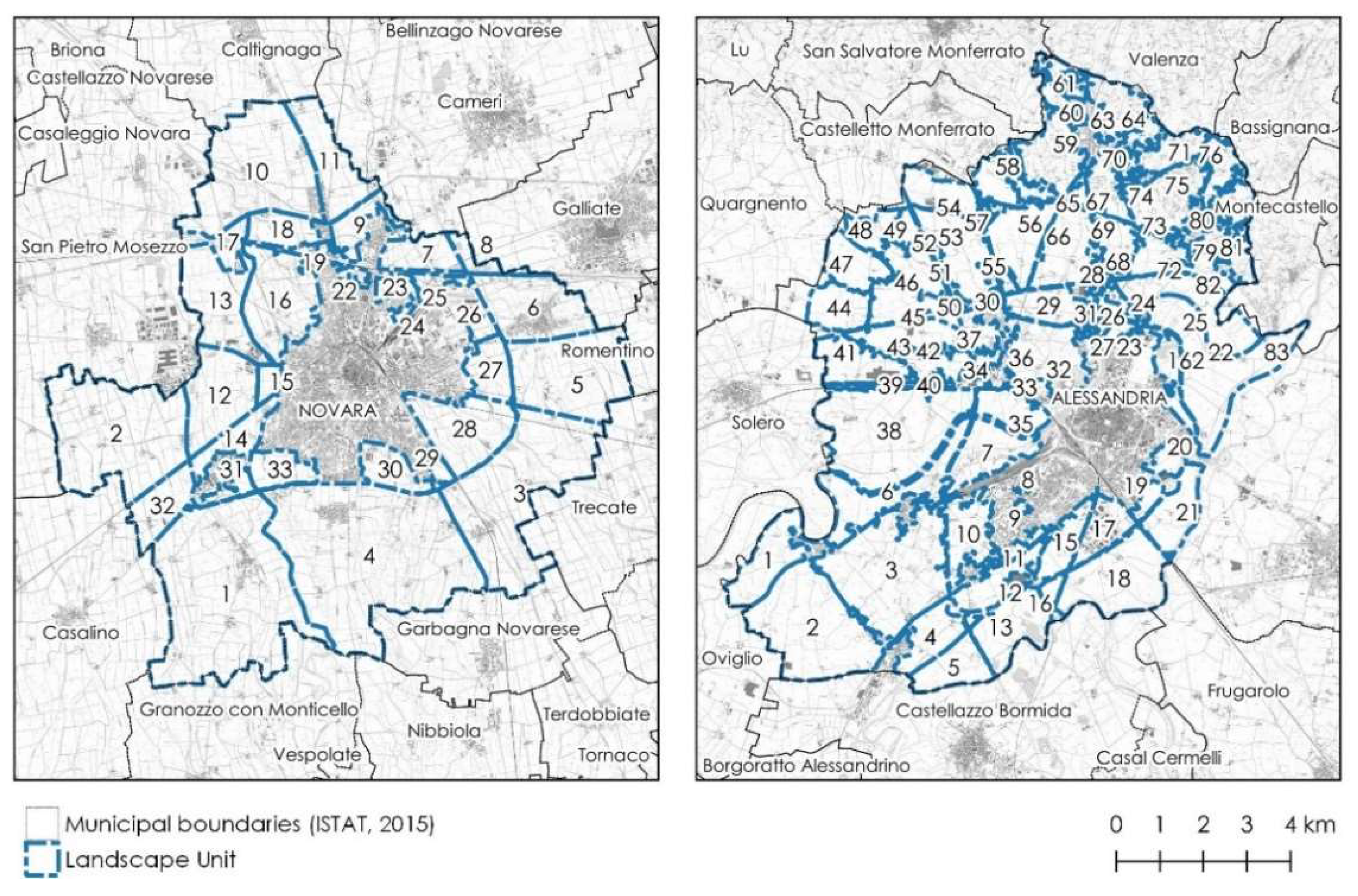
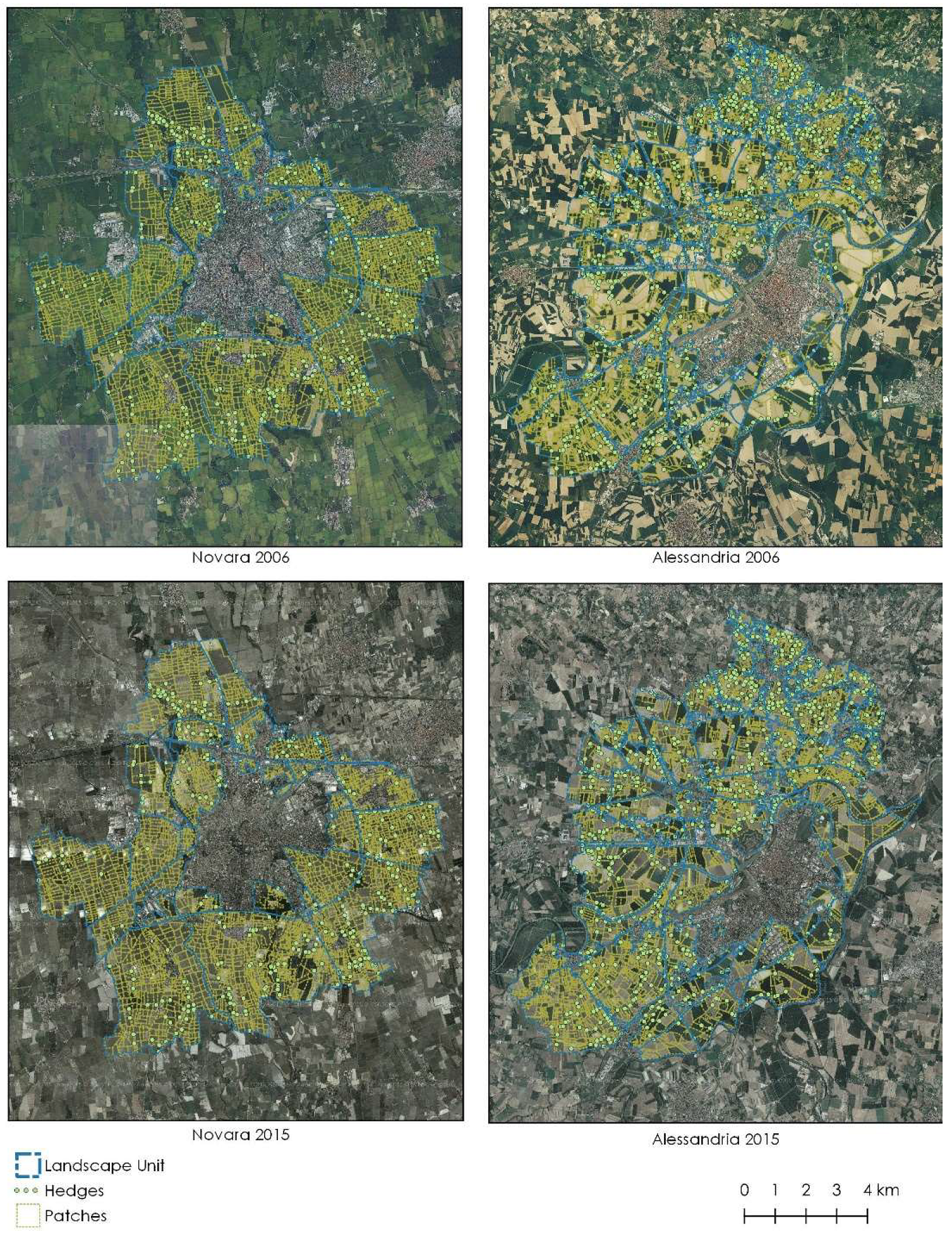
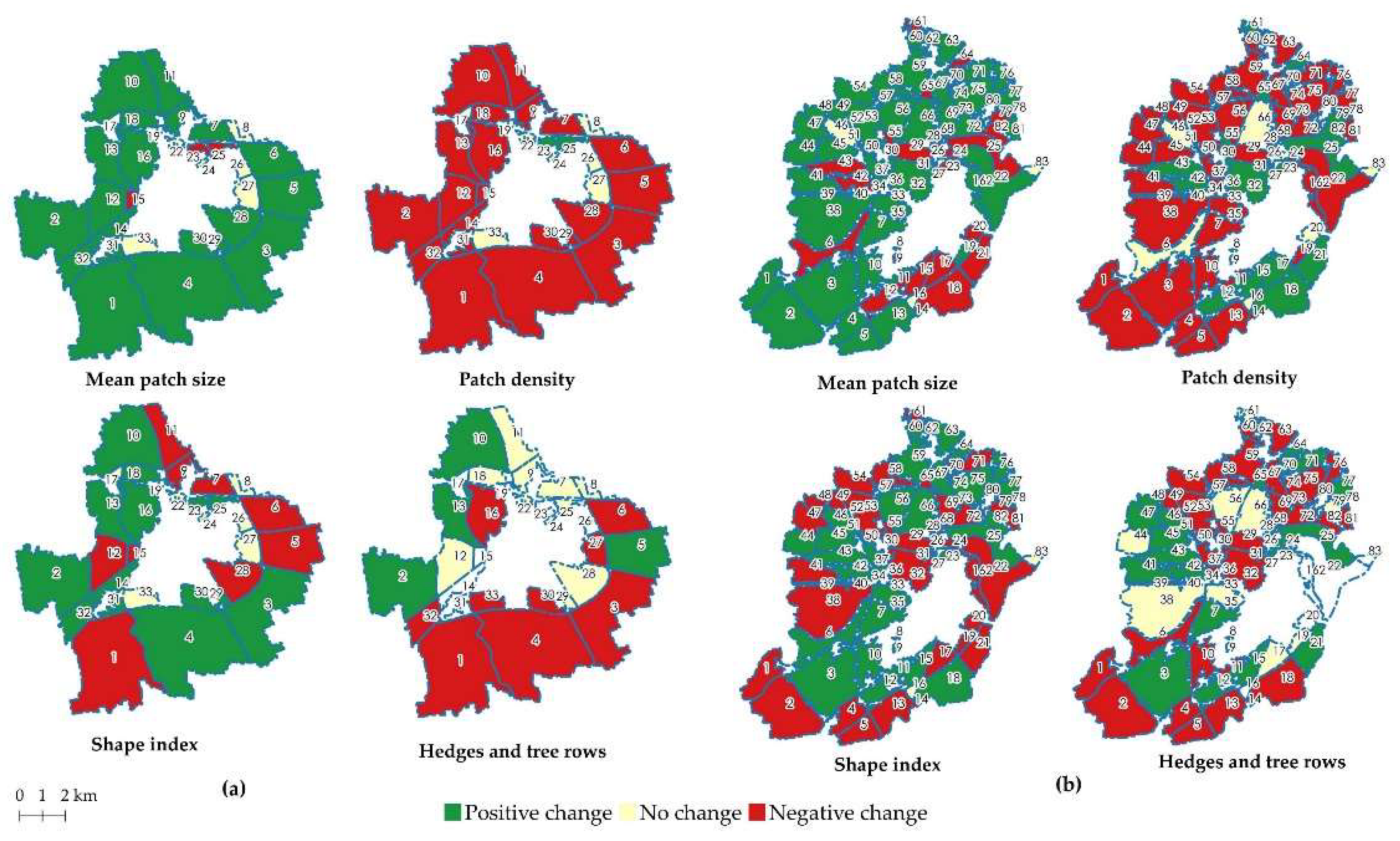

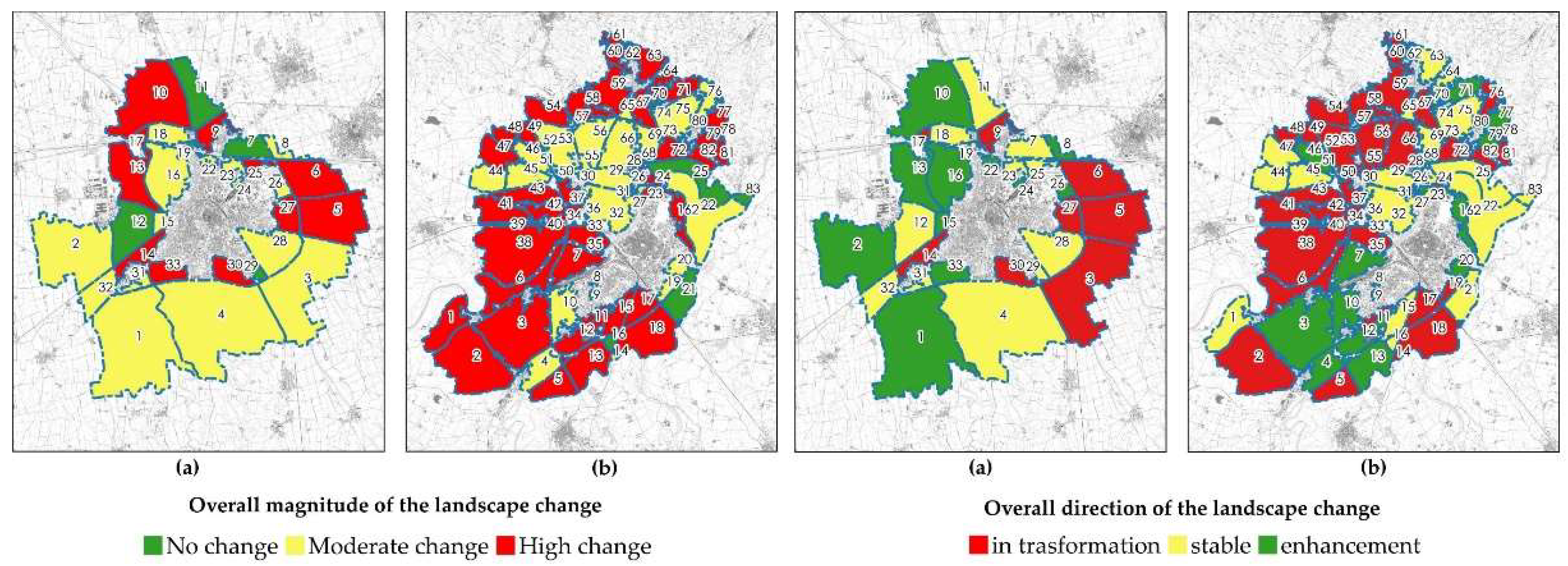
| Data | Producers, Year |
|---|---|
| Land consumption | Italian Institute for Environmental Protection and Re-search (ISPRA), 2008 and 2013 |
| Land cover and use at the supra-local scale (Corine land cover) | European Environment Agency (EEA), Joint Research Centre (JRC), Copernicus Land Monitoring Service, 2006, 2012 and 2018 |
| Forest land use, hedges | Piedmont Region Authority, IPLA, Regional Forest Plan (PFT), 2006 and 2016 |
| Population and Oldness Index | Italian National Institute of Statistics (ISTAT), 2011 and 2016 |
| Utilized agricultural area (UAA), total agricultural area, number of farms, organic areas | ISTAT, Agriculture Census, 2000 and 2010Piedmont Region Authority, Regional Farm Register (AAU), 2007 and 2015 |
| 2007–2013 RDP financial data | Piedmont Region Authority, Regional DWH for the 2007–2013 RDP |
| 2007–2013 CAP financial data (first pillar) | CSI Piemonte, 2015 |
| Indicators | Algorithms |
|---|---|
| shape factor | where: |
| visual variety | where: |
| Area Number | Denomination | Average Incidence of the CAP at Municipal Level (%) | Average Incidence of the RDP at Municipal Level (%) | Average Value of TAA Covered by Agro-Environment Measures at Municipal Level (%) |
|---|---|---|---|---|
| 01 | Alessandrino | 1.020 | 0.612 | 38.3 |
| 02 | Basse Langhe | 0.170 | 0.469 | 31.6 |
| 03 | Casalese | 0.042 | 0.029 | 33.9 |
| 04 | Cavourese | 0.278 | 0.273 | 13.2 |
| 05 | Monferrato Astigiano | 0.147 | 0.418 | 43.6 |
| 06 | Novarese | 0.407 | 0.154 | 20.2 |
| 07 | Piana cuneese | 0.965 | 0.533 | 6.4 |
| 08 | Vercellese | 0.434 | 0.139 | 29.4 |
| 09 | Alto Eporediese | 0.014 | 0.017 | 1.7 |
| 10 | Basso Canavese | 0.046 | 0.019 | 0.6 |
| 11 | Colline del Po | 0.009 | 0.022 | 14.3 |
| Regional average value (at municipal level) | 0.08 | 0.07 | 20.3 |
| Areas | Area Number | Denomination | Average Variation of Population 2011–2016 (%) | Average Variation of Oldness Index 2011–2016 (%) | Average Variation of Farm Number 2000–2010 (%) | Number of Farms at Meso Level (2010) | UAA/Total Territorial Surface at Meso Level (%) | Total CAP Support at Meso Level (EUR/farm) |
|---|---|---|---|---|---|---|---|---|
| Areas covered by CAP | 01 | Alessandrino | 5.31 | −9.19 | −25.92 | 933 | 69.1 | 104,692.50 |
| 02 | Basse Langhe | 6.64 | −8.65 | −27.50 | 1283 | 55.9 | 25,352.73 | |
| 03 | Casalese | −2.93 | −16.12 | −41.76 | 83 | 63.8 | 32,130.56 | |
| 04 | Cavourese | 8.77 | 13.23 | −43.64 | 1852 | 59.6 | 33,482.80 | |
| 05 | Monferrato Astigiano | 0.62 | −5.81 | −39.99 | 936 | 56.0 | 15,003.70 | |
| 06 | Novarese | 7.39 | −0.34 | −20.64 | 235 | 74.2 | 331,287.43 | |
| 07 | Piana cuneese | 8.79 | 17.23 | −12.93 | 2642 | 75.4 | 58,283.51 | |
| 08 | Vercellese | 1.17 | −20.10 | −17.36 | 109 | 76.5 | 381,621.96 | |
| Areas not or less covered by CAP | 09 | Alto Eporediese | −1.11 | 29.48 | −61.24 | 158 | 18.5 | 11,622.14 |
| 10 | Basso Canavese | 12.47 | 22.46 | −34.32 | 343 | 43.9 | 30,055.13 | |
| 11 | Colline del Po | 4.89 | 23.23 | −33.86 | 39 | 19.6 | 15,391.83 |
| Areas | Area Number | Denomination | Average UAA Variation 2007–2015 (%) | Average Land Consumption 08–13 (%) | Average Arable Land Variation 07–15 (%) | Average Permanent Crops Variation 07–15 (%) | Average Permanent Meadows Variation 07–15 (%) | Average Forest Variation 06–16 (%) | Average Wood Arboriculture Variation 06–16 (%) |
|---|---|---|---|---|---|---|---|---|---|
| Areas covered by CAP | 01 | Alessandrino | −1.61 | 6.75 | −3.85 | −25.64 | 105.03 | 56.15 | 0.59 |
| 02 | Basse Langhe | 2.04 | 5.98 | −19.23 | 7.24 | −14.48 | 11.44 | −41.36 | |
| 03 | Casalese | −2.26 | 3.75 | −7.87 | −25.33 | 172.40 | 8.22 | −32.07 | |
| 04 | Cavourese | −4.07 | 7.31 | −5.55 | −7.39 | −9.20 | 5.55 | 10.56 | |
| 05 | Monferrato Astigiano | −0.29 | 14.10 | −12.24 | 3.09 | 30.39 | 5.36 | −5.94 | |
| 06 | Novarese | −1.25 | 5.80 | −1.55 | 734.04 | 193.66 | −14.12 | −14.62 | |
| 07 | Piana cuneese | −1.18 | 5.53 | −3.46 | 478.98 | 9.34 | 5.92 | −58.55 | |
| 08 | Vercellese | −1.60 | 6.03 | −1.58 | 0.00 | 10.93 | 41.41 | 11.52 | |
| Average value | −1.28 | 6.91 | −6.92 | 145.62 | 62.26 | 14.99 | −16.23 | ||
| Areas not or less covered by CAP | 09 | Alto Eporediese | 5.33 | 5.65 | −18.82 | 31.13 | 60.73 | −3.30 | 324.63 |
| 10 | Basso Canavese | −10.19 | 5.00 | −29.43 | 25.17 | 22.41 | 43.10 | 26.54 | |
| 11 | Colline del Po | −4.92 | 0.21 | −22.42 | −13.66 | 36.52 | 7.55 | 0.10 | |
| Average value | −3.26 | 3.62 | −23.56 | 14.22 | 39.89 | 15.78 | 117.09 | ||
| Land Use Class | Novara | Alessandria | ||||
|---|---|---|---|---|---|---|
| 2006 | 2015 | Var. % | 2006 | 2015 | Var. % | |
| Urbanized areas | 548.7 | 561.95 | 2.4 | 235.5 | 347.32 | 47.5 |
| Renaturalized and/or reforested areas | 0 | 3.24 | 100.0 | 8.15 | 37.22 | 356.7 |
| Renewable energy installations | 0 | 26.9 | 100.0 | |||
| Invasive forests | 7.1 | 85.78 | 1108.2 | 0.46 | 13.36 | 2804.3 |
| Abandoned crops | 28.74 | 38.44 | 33.8 | 38.43 | 46.92 | 22.1 |
| Orchards and vineyards | 51.4 | 56.18 | 9.3 | |||
| Arboriculture | 464.9 | 302.15 | −35.0 | 182.89 | 108.91 | −40.5 |
| Stable meadows | 117.27 | 74.23 | −36.7 | 273.17 | 409.27 | 49.8 |
| Oak and hornbeam forests | 19.33 | 19.01 | −1.7 | |||
| Riparian vegetation | 18.86 | 0.51 | −97.3 | 132.25 | 164.62 | 24.5 |
| Arable land | 6941.82 | 6992.23 | 0.7 | 7811.2 | 7471.09 | −4.4 |
| Landscape Metric | Novara | Alessandria |
|---|---|---|
| Hedges 2006 (Km) | 64.80 | 133.48 |
| Hedges 2015 (Km) | 62.62 | 128.50 |
| Change 2006–2015 (%) | −3.36 | −3.73 |
| Number of patches 2006 | 3750 | 4475 |
| Number of patches 2015 | 3659 | 4216 |
| Change 2006–2015 (%) | −2.43 | −5.79 |
| Mean patch size 2006 (ha) | 1.68 | 1.85 |
| Mean patch size 2015 (ha) | 1.73 | 1.94 |
| Change 2006–2015 (%) | 2.98 | 4.86 |
| Patch density 06 | 0.45 | 0.49 |
| Patch density 15 | 0.44 | 0.47 |
| Change 2006–2015 (%) | −2.22 | −4.08 |
| Shape factor 2006 | 1.2934 | 1.4352 |
| Shape factor 2015 | 1.2968 | 1.4371 |
| Change 2006–2015 (%) | 0.26 | 0.13 |
| Number of land use class 2006 (n.) | 14 | 11 |
| Number of land use class 2015 (n.) | 12 | 13 |
| Change 2006–2015 (%) | −14.29 | 18.18 |
| Visual variety 2006 | 0.1943 | 0.2165 |
| Visual variety 2015 | 0.1927 | 0.2592 |
| Change 2006–2015 (%) | −0.82 | 19.72 |
Publisher’s Note: MDPI stays neutral with regard to jurisdictional claims in published maps and institutional affiliations. |
© 2021 by the author. Licensee MDPI, Basel, Switzerland. This article is an open access article distributed under the terms and conditions of the Creative Commons Attribution (CC BY) license (https://creativecommons.org/licenses/by/4.0/).
Share and Cite
Gottero, E. Rural Landscape Changes in the Piedmont Region (Italy). A Method for the Interpretation of Possible Effects of CAP. Sustainability 2021, 13, 13062. https://doi.org/10.3390/su132313062
Gottero E. Rural Landscape Changes in the Piedmont Region (Italy). A Method for the Interpretation of Possible Effects of CAP. Sustainability. 2021; 13(23):13062. https://doi.org/10.3390/su132313062
Chicago/Turabian StyleGottero, Enrico. 2021. "Rural Landscape Changes in the Piedmont Region (Italy). A Method for the Interpretation of Possible Effects of CAP" Sustainability 13, no. 23: 13062. https://doi.org/10.3390/su132313062
APA StyleGottero, E. (2021). Rural Landscape Changes in the Piedmont Region (Italy). A Method for the Interpretation of Possible Effects of CAP. Sustainability, 13(23), 13062. https://doi.org/10.3390/su132313062






